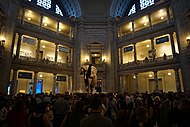
National Museum of Natural History
The National Museum of Natural History (NMNH) is a natural history museum administered by the Smithsonian Institution, located on the National Mall in Washington, D.C., United States. It has free admission and is open 364 days a year. With 4.4 million visitors in 2023, it was the second most-visited museum in the United States.[6]
This article is about the museum in Washington, D.C. For the museum in New York City, see American Museum of Natural History. For national museums in other countries, see National Museum of Natural History (disambiguation).Established
Opened in 1910, the museum on the National Mall was one of the first Smithsonian buildings constructed exclusively to hold the national collections and research facilities.[7] The main building has an overall area of 1.5 million square feet (140,000 m2) with 325,000 square feet (30,200 m2) of exhibition and public space and houses over 1,000 employees.[7]
The museum's collections contain over 146 million specimens[8] of plants, animals, fossils, minerals, rocks, meteorites, human remains, and human cultural artifacts, the largest natural history collection in the world.[9] It is also home to about 185 professional natural history scientists—the largest group of scientists dedicated to the study of natural and cultural history in the world.
History[edit]
1846–1911[edit]
The United States National Museum was founded in 1846 as part of the Smithsonian Institution. The museum was initially housed in the Smithsonian Institution Building, which is better known today as the Smithsonian Castle. A formal exhibit hall opened in 1858.[10] The growing collection led to the construction of a new building, the National Museum Building (known today as the Arts and Industries Building). Covering a then-enormous 2.25 acres (9,100 m2), it was built in just 15 months at a cost of $310,000. It opened in March 1881.[11]
Congress authorized construction of a new building on June 28, 1902.[12][13] On January 29, 1903, a special committee composed of members of Congress and representatives from the Smithsonian's board of regents published a report asking Congress to fund a much larger structure than originally planned.[13] The regents began considering sites for the new building in March, and by April 12 settled on a site on the north side of B Street NW between 9th and 12th Streets.[14][15] The D.C. architectural firm of Hornblower & Marshall was chosen to design the structure.[15] Testing of the soil for the foundations was set for July 1903, with construction expected to take three years.[16]
Research and collections[edit]
Research in the museum is divided into seven departments: anthropology, botany, entomology, invertebrate zoology, mineral sciences, paleobiology, vertebrate zoology.[7]
The NMNH represents 90% of the Smithsonian Institution’s collections and forms one of the largest, most comprehensive natural history collection in the world.[47] The Smithsonian gives an approximate number for artifacts and specimens of 146 million.[48] More specifically, the collections include 30 million insects, 4.5 million plants preserved in the Museum's herbarium, and 7 million fish stored in liquid-filled jars.[49] The National Collection of Amphibians and Reptiles has more than tripled from 190,000 specimen records 1970 to over 580,000 specimen records in 2020.[50][51] Of the 2 million cultural artifacts, 400,000 are photographs housed in the National Anthropological Archives.[49] Through off-site active loan and exchange programs, the museum's collections can be accessed.[52] As a result, 3.5 million specimens are out on loan every year.[49] The rest of the collections not on display are stored in the non-public research areas of the museum and at the Museum Support Center, located in Suitland, Maryland.[53] Other facilities include a marine science center in Ft. Pierce, Florida and field stations in Belize, Alaska, and Kenya.[49]
The museum is estimated to hold more than 5000 Native American remains that have not been repatriated. Some of these may belong to the Seminole Tribe of Florida.[54]
One collection of nearly a million specimens of birds, reptiles, and mammals kept at the museum has been maintained by the Biological Survey unit of the U.S. Geological Survey. This division had started in 1885 as an economic ornithology unit of the Agriculture Department. Clarence Birdseye and Clinton Hart Merriam had worked in this organization. As of February 2018, the unit's funding is planned to be cut, and it is not clear what would happen to the collection.[55]






